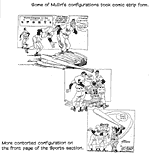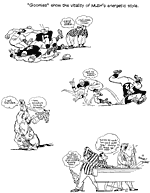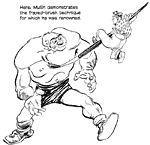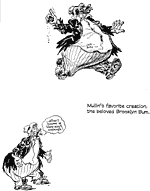
Willard Mullin
The Champion
of the Sporting Life
(This article appeared previously in The Comics Journal)
Willard Mullin, the nation’s foremost sports cartoonist,
secured his place in the lore of the National Cartoonists Society at the
regular monthly meeting on
“Mr.
President,” he slurred, “may I call you a son’v’
bitch?”
Caniff looked down the table to Marge Devine, NCS’s faithful scribe, and said: “Margie, are his dues paid?”
“Yes,”
she said, over the chuckles on all sides.
“Willard,”
Caniff said, turning to the weaving sports page
giant, “you have permission.”
“Okay—you’re
a son’v’bitch,” Mullin intoned. And then he
sat down quietly and disappeared almost at once below the horizon of the
table.
Mullin,
like everyone worth mentioning in sports, played hard.
Mullin
had first loomed up on the horizon in Franklin, Ohio, on September 14,
1902, christened Willard Harlan by his father, Milo Mayberry Mullin, a
dairy farmer, and his mother, Edna Marie Ballard. The Mullins moved to
“Every
chance I got, I would work nights to try to get a sports cartoon into
the paper,” Mullin said. Over the years, his sports cartoons appeared
more and more frequently, but Mullin remained a general assignment artist
rather than a sports specialist.
In
1929, Mullin got married in
They
got married in
In
the fall of 1934, Mullin heard that the
New York World Telegram was looking for a sports cartoonist. “All the clips and originals of my sports stuff
I could lay hands on were forwarded to Joe Williams [satrap of the sports
page at the World Telegram],”
Mullin said. “I must have sent a bale of stuff: postage alone came to
$5. And that was a lot of dough to me in those days. Something must have pleased him: I was the lucky one to get
the job.”
It
was the job he had “always wanted,” he said, and he remained with the
paper until it collapsed in 1967, casualty of a disastrous succession
of printers’ strikes that destroyed
For
most of his 33-year career with the World
Telegram, Mullin’s cartoon ran large across the top of the first page
in the sports section, five or six columns wide on an eight-column format,
six days a week. The page layout was modified to suit whatever configuration
Mullin conjured up for his cartoon, and the cartoonist, believing that
one of the chief purposes of a sports cartoon is to “dress up the page,”
exploited this sufferance, often producing a cartoon of irregular shape—tall
and skinny, fat and wide, or gerrymandered to fit the shape of the figures
in the picture. Just as his cartoon dominated his paper’s sports section,
so did Mullin tower over his profession: his distinctive style soon set
the fashion for all sports cartoonists.
A sports
cartoon, Mullin once wrote, should “tell a story, get over a point, cover
some news, or bring a laugh.” On a good day, he said, he’d get all four
in one cartoon. He conceived his cartoons as if he were writing a
sports column. An opinion column, not a newsstory.
In covering a sporting event, he looked beyond the event itself. “It would
seem superfluous to tell the story of a particular World Series game as
such,” he said. “Rather, the significance to the Series of that particular
game or the pre-game dope would be a better angle for a cartoon. It’s
my belief that a sports cartoonist should be a personality himself. He
should take a stand on things, stick his neck out on predictions and guesses
and not merely report an event.”
Typically,
Mullin declared his subject for the day with a large realistically rendered
portrait of an athlete; and then he developed his story—an observation
or comment on the athlete’s most recent accomplishment—in a series of
small figures (sometimes called “goomies”),
often caricatures of the principal subject, in topical vignettes that
surrounded the large picture. Sometimes the large drawing depicted generic
athletes of a particular sport, and Mullin’s commentary explored the state
of that sport or some aspect of the news about it. Sometimes his cartoon
took shape as a series of narrative pictures in comic strip form. He considered
everything—and he capitalized it: EVERYTHING—legitimate
grist for his mill. Advising would-be sports cartoonists, he said: “Don’t
let your mind be bounded on the north by baseball and on the south by
football, on the west by hockey and basketball and on the east by racing.
The news in the daily papers—that goes for the front page and the editorials,
current plays and bestseller books—all may [furnish] a hook to hang a
gag or situation on. History is a great source of situations that could
be analogous to some sports situation. Literature is a great prop.”
Mullin
was an ardent sports fan, and his passion showed in the vigor of his drawings.
To preserve the energy of the creative act itself, he worked from preliminary
sketch to final drawing on the same piece of art paper. In his drawings,
he tried to capture the feel rather than just the appearance of the action.
To this end, he exaggerated both anatomy and motion, enlisting the entire
figure in his expression of an idea. "You start with the thought
and feeling of the action,” he said. “A few lines will give you the sweep
of the runner’s legs and forward thrust of his body.”
Mullin’s
football player running for a touchdown did not simply run: he bent forward
at the waist and again at the ankles, assuming a charging, jutting off-balance
posture that however impossible in actuality was vivid in suggesting the
velocity and determination of his progress.
Mullin’s
athletes were bony and muscular caricatures of their breed; supple in
motion, loose-limbed and sinewy rather than muscle-bound, they captured
perfectly the pure physicality of sport. The large pictures in his cartoons
were rendered in matchless fluid line with a brush; the smaller action
figures, with a delicate penline. “A brush is a versatile tool,” he said. When he came
to ink his drawing, he preferred to use “an old No. 3 Winsor
Newton, slightly moth-eaten with uneven hairs at the end—in short, a brush
you can’t quite handle. This gives freedom and interesting incidental
lines.” Mullin usually gave the large rendering in his cartoon a soft,
gray tone by shading pebble-finish art paper with a crayon; the small
pictures he embellished with strategically placed solid blacks and gray
tones.
During
his last seventeen years with the World
Telegram, Mullin worked at home in Plandome.
His usual workday began at
In
later years, though, he could do the day’s cartoon in fewer hours. “It’s
not so much the added facility of your skills as the ever-increasing background
and knowledge you pile up that makes for quicker and more efficient production,”
he wrote in what passes for his autobiography, A
Hand in Sport. (A notable volume, composed with the help of sports
writer Dave Camerer, it offers only 30 pages
of autobiographical text but 190 pages of cartoons reprinted from every
period of Mullin’s career with his running commentary underneath each
picture. The dust jacket illustration—a giant hand with athletes of all
sorts standing in the palm—was originally intended to grace a biography
of sports writer Grantland Rice; it wasn’t used for that, however, so Mullin
used it here and probably entitled the tome to suit the picture.)
About
the art of cartooning, Mullin said: “I don’t lose sight that cartooning,
while it’s a definite art form, is not putting oil to canvas. I work on
a conveyor belt basis—six days a week, including Saturdays—and, quite
frankly, I’d have been wearing a double-breasted straitjacket years ago
if I demanded absolute perfection—something I shoot for, naturally, but
seldom realize.”
In
addition to drawing his daily cartoon, Mullin illustrated hundreds of
advertisements, books, and articles in such magazines as Life, The Saturday Evening Post, Look, Time,
and Newsweek. Asked, once, which
of his cartoons was his favorite, he said, “That’s like asking a fruit
dealer to name his best individual orange.”
His
work appears in few books, most of which he illustrated for others: Menke’s Encyclopedia of Sports (1944), John Lardner’s
It Beats Working (1947), Red
Smith’s Out of the Red (1950).
He also edited and illustrated The
Junior Illustrated Encyclopedia of Sports (1960) with Herbert Kamm
and wrote and illustrated Lesson 23 of the Famous Artists Cartoon Course
(c. 1955) in which he explains in graphic detail how he composes his cartoons.
According to Mullin, the only substantial collection of his original art
is held in the manuscript collection of the Bird Library at
His
pictures became virtually synonymous with sports; his symbols, their visual
lexicon. Football teams were represented by their mascots (usually animals),
basketball players were skinny and awkward, and boxers were wide-eyed
innocents. The New York Giants he depicted as a huge, amiable lout with
huge feet and a tiny head; the Milwaukee Brave was beer-bellied (in recognition
of the brew for which the city was famed); St. Louis Swifty,
a Mississippi riverboat gambler, was a “card” sharp (evoking the nickname
for the Cardinals); the New York Yankees were somewhat snooty city-slickers
in pinstripe uniforms. Mullin’s prized creation, however, was the Bum
who stood for the Brooklyn Dodgers before the Dodgers moved to
The
beloved tramp was born one day in the late 1930s just after the underdog
Dodgers lost another one at Ebbets Field. Mullin
was taking the cab back to the newspaper office, and the driver asked
him, “How’d our bums do today?” The next day, the woebegone hobo debuted
in the newspaper.
“I
admit that the Brooklyn Bum is my deepest professional delight,” Mullin
said. “It’s not that he’s pretty—he ain’t; it’s
simply that he affords a wonderful peg from which to hang any baseball
idea that can be tied to the Dodgers.”
And not just the Dodgers. And not just baseball.
“The Bum has given me a lingo that blends, occasionally, to an entirely
different character,” Mullin said. By way of example, he cited the cartoon
he drew commemorating the deadline for submitting income tax. “I drew
the Bum that day in the throes of anguish. Up to his scuppers in government
forms, the Bum says, ‘It won’t be the first of September I can’t get this
thing done until.’ Aside to Shakespeare, Marlowe, and Johnson: This is
the perfect King’s English—King’s County,
“By
now, I think of the Bum as being alive,” he went on, “complete with a
personality (he’d say poisonality) of his own.
Out of his own cock-sureness and belligerence,
the ideas come in flocks—to the point where I actually have to ration
my ideas about the Brooklyns, bless ’em.”
Out
of our world of sports, Mullin fabricated another world, part fanciful,
part real, all his own. “If you are like most of us,” Joe Williams wrote
in the introduction to A Hand in
Sport, “you find that you have cheerfully taken up residence in Mullin’s
personally constructed Never Never Land, a land
where nothing could be more normal than ten pins that walk and talk and
rout bowlers with indignant furies; where beer guzzling Indians with aldermanic
bellies and fierce Milwaukee loyalties argue baseball in a German dialect
that is an inspired mixture of Weber and Fields and pure Sioux; and, of
course, amid such commonplace and conventional behaviors, you quite naturally
expect to find a garrulous, aromatic, unwashed bum in skidrow
tatters who, until he moved west, interpreted the emotions and philosophies
of the most populous borough in America’s largest city.
“Now,
gentleman,” he concludes, “you simply don’t get that way on vin ordinaire. You must treat yourself to the
distillation of a very special kind of grape. It goes without saying it
will be the kind you won’t find just any old place. We’ve heard some people
call it the ‘heady wine of genius.’”
The
grape of genius wasn’t the only intoxicant in Mullin’s world. He enjoyed
saloon life, consuming both food and drink with appreciative gusto, and
was close friends with many fellow habitues
of
Sports
columnist Red Smith wrote: “For approximately forever, Mullin did a daily
cartoon . . . . The National Cartoonists Society saluted him as Sports
Cartoonist of the Century, an understatement. He was the sports cartoonist
of the eras, including the Paleozoic, because there never was another
who combined such news sense and wit and perception with such a comic
pen.”
Mullin
died of cancer while visiting his daughter in
Here's
a gallery of Mullintoons.
 |
 |
 |
 |
 |
